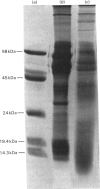Abstract
Nuclear envelopes and nuclear matrices were isolated from the male-rat liver. Incubation of 125I-labelled 3,3',5-tri-iodothyronine (T3) with the nuclear-envelope fraction resulted in specific binding of T3 to the membranes. Maximum specific binding occurred at 30 degrees C after 2h incubation. Storage for 1 week at -80 degrees C resulted in no loss of binding. Scatchard analysis revealed a class of binding sites with KD 86 nM. 3,3',5'-Tri-iodothyronine was as effective a competitor of [125I]T3 binding to nuclear envelopes as was L-T3 itself, and tri-iodothyroacetic acid was 70% as potent as T3. L- and D-thyronine did not compete for [125I]T3 binding. Incubation of nuclear envelopes with 0.6 M-NaCl before addition of T3 resulted in the complete loss of specific binding sites, whereas exposure of the membranes to 2.0 M-NaCl after incubation with T3 did not extract binding sites. Nuclear matrices, after incubation with [125I]T3 under the same conditions, were shown to possess a class of binding sites with a similar KD but with approx. 30% of the maximum binding capacity. Nuclear envelopes from hypothyroid animals may possess slightly lower numbers of binding sites compared with nuclear envelopes from the intact animal, whereas nuclear matrices from hypothyroid animals have the same number of binding sites as do nuclear envelopes from the intact animal. In conclusion, nuclear envelopes and nuclear matrices have a class of binding sites with relatively high affinity for T3. It is distinct from nuclear and cytosolic binding sites.
Full text
PDF






Images in this article
Selected References
These references are in PubMed. This may not be the complete list of references from this article.
- Aaronson R. P., Blobel G. Isolation of nuclear pore complexes in association with a lamina. Proc Natl Acad Sci U S A. 1975 Mar;72(3):1007–1011. doi: 10.1073/pnas.72.3.1007. [DOI] [PMC free article] [PubMed] [Google Scholar]
- Agutter P. S., Gleed C. D. Variability of mammalian liver nuclear-envelope preparations. Biochem J. 1980 Oct 15;192(1):85–89. doi: 10.1042/bj1920085. [DOI] [PMC free article] [PubMed] [Google Scholar]
- Barrack E. R., Coffey D. S. The specific binding of estrogens and androgens to the nuclear matrix of sex hormone responsive tissues. J Biol Chem. 1980 Aug 10;255(15):7265–7275. [PubMed] [Google Scholar]
- Davis P. J., Handwerger B. S., Glaser F. Physical properties of a dog liver and kidney cytosol protein that binds thyroid hormone. J Biol Chem. 1974 Oct 10;249(19):6208–6217. [PubMed] [Google Scholar]
- DeGroot L. J., Torresani J. Triiodothyronine binding to isolated liver cell nuclei. Endocrinology. 1975 Feb;96(2):357–359. doi: 10.1210/endo-96-2-357. [DOI] [PubMed] [Google Scholar]
- Dillman W., Surks M. I., Oppenheimer J. H. Quantitative aspects of iodothyronine binding by cytosol proteins of rat liver and kidney. Endocrinology. 1974 Aug;95(2):492–498. doi: 10.1210/endo-95-2-492. [DOI] [PubMed] [Google Scholar]
- Kay R. R., Fraser D., Johnston I. R. A method for the rapid isolation of nuclear membranes from rat liver. Characterisation of the membrane preparation and its associated DNA polymerase. Eur J Biochem. 1972 Oct 17;30(1):145–154. doi: 10.1111/j.1432-1033.1972.tb02081.x. [DOI] [PubMed] [Google Scholar]
- LOWRY O. H., ROSEBROUGH N. J., FARR A. L., RANDALL R. J. Protein measurement with the Folin phenol reagent. J Biol Chem. 1951 Nov;193(1):265–275. [PubMed] [Google Scholar]
- Laemmli U. K. Cleavage of structural proteins during the assembly of the head of bacteriophage T4. Nature. 1970 Aug 15;227(5259):680–685. doi: 10.1038/227680a0. [DOI] [PubMed] [Google Scholar]
- Oppenheimer J. H., Schwartz H. L., Surks M. I. Nuclear binding capacity appears to limit the hepatic response to L-triiodothyronine (T3). Endocr Res Commun. 1975;2(4-5):309–325. doi: 10.1080/07435807509089004. [DOI] [PubMed] [Google Scholar]
- Oppenheimer J. H. Thyroid hormone action at the cellular level. Science. 1979 Mar 9;203(4384):971–979. doi: 10.1126/science.218285. [DOI] [PubMed] [Google Scholar]
- Schwartz H. L., Oppenheimer J. H. Physiologic and biochemical actions of thyroid hormone. Pharmacol Ther B. 1978;3(3):349–376. doi: 10.1016/s0306-039x(78)80002-6. [DOI] [PubMed] [Google Scholar]
- Silva E. S., Astier H., Thakare U., Schwartz H. L., Oppenheimer J. H. Partial purification of the triiodothyronine receptor from rat liver nuclei. Differences in the chromatographic mobility of occupied and unoccupied sites. J Biol Chem. 1977 Oct 10;252(19):6799–6805. [PubMed] [Google Scholar]
- Smith H. C., Robinson S. E., Eastman C. J. Binding of endogenous iodothyronines to isolated liver cell nuclei. Endocrinology. 1980 Apr;106(4):1133–1136. doi: 10.1210/endo-106-4-1133. [DOI] [PubMed] [Google Scholar]
- Surks M. I., Koerner D. H., Oppenheimer J. H. In vitro binding of L-triiodothyronine to receptors in rat liver nuclei. Kinectics of binding, extraction properties, and lack of requirement for cytosol proteins. J Clin Invest. 1975 Jan;55(1):50–60. doi: 10.1172/JCI107917. [DOI] [PMC free article] [PubMed] [Google Scholar]
- Visser T. J., Bernard H. F., Docter R., Hennemann G. Specific binding sites for L-triiodothyronine in rat liver and kidney cytosol. Acta Endocrinol (Copenh) 1976 May;82(1):98–104. doi: 10.1530/acta.0.0820098. [DOI] [PubMed] [Google Scholar]
- Widnell C. C., Tata J. R. A procedure for the isolation of enzymically active rat-liver nuclei. Biochem J. 1964 Aug;92(2):313–317. doi: 10.1042/bj0920313. [DOI] [PMC free article] [PubMed] [Google Scholar]
- Wilson B. D., Albrecht C. F., Wium C. A. The specific binding of the thyroid hormones to matrix isolated from rat liver nuclei. S Afr Med J. 1982 Jan 9;61(2):44–49. [PubMed] [Google Scholar]



